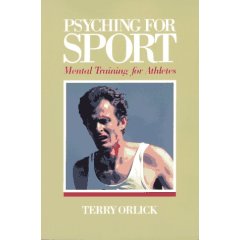It is important for athletes to be properly prepared mentally so that they have reached the optimal mental state for competition. It is also imperative to have a mental plan in place to deal with unexpected occurrances. Finally, crews need to communicate well as each athelte will have their own best mental preparation for a race.
A related article appeared in the same journal referenced in the previous post titled, "Bring Your Mind to the Line."
Mental Preparation is highly individualized.
The few athletes and coaches I know who do follow a mental preparation plan tend to script it as much as any physical warm-up. They follow either what worked best for them, or what they read in a particular book or article with little attention to the needs of a specific individual or crew.Research shows that every athlete has their own mental state in which they perform best. One rower may need to focus on who they are racing against and need to be highly energized to race well - like going into battle. Others perform best when they take a more cerebral approach - focsing on technique and their own best race. Still others are best when distracted and relaxed. There are as many approaches to mental preparation as there are rowers.
Having these individual mental states blend well in a crew is a key to the art of coaching. Coaches have their own way of mentally approaching a race and if they don't fit well with a particular athlete it is unlikely that a top performance will ensue. Even if a coach is flexible in her approach, how do they deal with the one or two atheltes whose best mental preparation is at odds with the rest of the crew?
This is doubly difficult if the coach and athlete have yet to work out the best mental preparation strategy. Having younger, or less experienced, athletes recognize their own optimal state is a significant challenge. Without a delibarate approach to this it can take a young rower many years to really learn about themselves.
How can an athlete identify their optimal state?
If you have enough experience to draw on, think back to past strong performances. How were you feeling on the day of a top performance. How did you go about preparing yourself? Do you row best under the direction of a certain coach - perhaps their approach to the race fits you well.A journal is a valuable tool to have for exercises like this. I would also add that you should consider your optimal state in strong training sessions. How many crews perform well in training but not in competition? Perhaps the rowers’ actual best mental state came about in training. This often means that this athlete needs a mroe relaxed atmosphere in terms of race preparation, or one where they feel in control of all variables.
The reverse can also be true – athletes that "bring it on race day" may actually need to consider their mental plan for training sessions. Perhaps they have made less than optimal use of their training plan because they dd not properly prepare for practice sessions.
Develop a Routine to Attain the Proper Pre-competition Mental State
Should you review the competition before the race or think about your own race, or perhaps even be completely distracted? Many coaches would choose one of these specifically - but for different athletes the correct answer could be any one of them.Is it useful to have a mental rehearsal of the race? If imagery is part of the plan - consider how that imagery will affect you - there are so many things that can be said in a visualization session that can put an athelte in a variety of mental states.
I would encourage you to consider the mental approach to various situations at the competition site - weather changes, schedule changes, equipment issues, and so on. Having prepared yourself for each of these is key to a successful race.
Consider the Individual
It is important as well to discuss these things between coach and all members of a crew. This can be an important part of early season racing, debriefing and learnign how the various members of a crew need to approach race day before the big competition occurs.Similarily coaches need to understand that their own preferred aproach to a race may not be the same as some of their atheltes' approaches. A fire and brimstone, marines landing to take an island speech works for some crews - but not for others. How well they can work together may determine the success of a crew on race day.
While the level of excitment and general preparation for individuals matters a great deal - there is important information in the details of the day as well.
For example, Johnny needs his whole crew to be clear that he prefers not to talk if there is a race delay on the water. Jimmy though needs his crew to know he likes to get excited and do a lot of positive self-talk. Some athletes will want to kill extra time with easy paddling and trying to put the race out of their minds. Others will want to do a few more starts or simulations of key parts of the race plan. If these things have been discussed ahead of time and an approach ageed upon then a crew is far more likely to succeed in different situations.
What is key is that you have a plan and that everyone in a crew is a part of that plan. It can make the difference between winning and losing, before the race has even begun.
If you enjoyed this post or other information on the site, subscribe to the Rowing Science Newsletter for regular updates and exclusive insider information for subscribers only.


